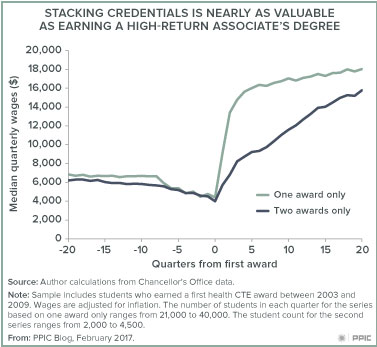Upward mobility is inextricably tied to educational attainment in today’s economy. How do California’s educational institutions foster upward mobility for their students when developing their programs of study? One way community colleges across the country are working to do so is through the development of training pathways that allow students to “stack” multiple credentials. The idea is that students can earn certificates or degrees sequentially and move up a career ladder—upward mobility in action. For example, a student who completes a certificate in medical assisting can return to complete additional training and earn a degree in registered nursing—an occupation that offers large wage returns.
Despite the promise of “stackable credentials,” our analysis of students enrolled in health programs at California’s community colleges finds that among those who earn one credential, most don’t go on to get another. We followed the 85,000 students who earned their first health degree between 2000 and 2009. Only 13 percent completed a second health credential within six years. This isn’t terribly surprising since about half of health students in California’s community colleges initially earned an associate degree—the highest level award that is offered. Many associate degrees in health lead to well-paying jobs such as registered nurse or dental hygienist. But even among students who earned a shorter-term, lower-return credential, only 20 percent returned to earn another health credential.

However, the evidence suggests that students who do stack multiple health credentials see sizable economic returns eventually (see figure). Median earnings are similar across the two groups of students before starting their health training programs and while they are in school. The wage trajectories diverge, however, after degree completion. Students completing a single award—most often an associate degree—earn more than $15,000 per quarter just one year after finishing their health degree. In comparison, those completing multiple awards—a shorter-term, lower-return certificate is the most prevalent first degree—earn only $8,000 a year out. This difference narrows considerably over a five year period when students completing a second health credential see a larger gradient in their earnings.
Currently, most students who “stack” health credentials ultimately attain an associate degree in nursing—one of the highest value awards offered in the community college system. It’s plausible to imagine building pathways that allow students to meaningfully stack credentials to other high-value, in-demand careers. But to do so, colleges must carefully align program curricula to ensure that skills gained along the way are sequential or complementary, while at the same time making sure that each credential has standalone value in the labor market. This is not an easy task but one our community college system is currently focused on, given state and federal investment in growing career pathways.
At the same time, community colleges are investing in ways to support students as they explore pathways to well-paying careers. All of these efforts, taken together, hold promise for increasing the number of students who improve their economic standing through engagement with training pathways available through California’s community colleges.
Read the report Health Training Pathways at California’s Community Colleges
Visit the PPIC Higher Education Center



